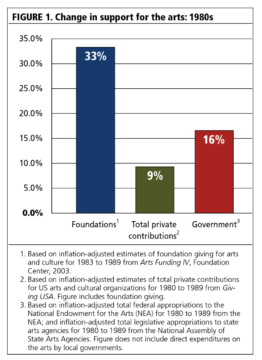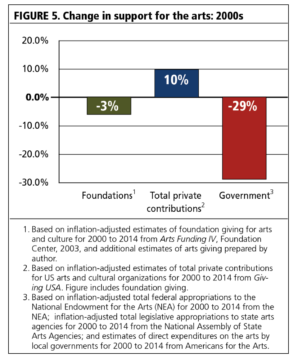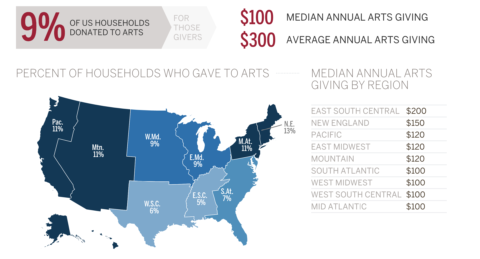What is Giving Compass?
We connect donors to learning resources and ways to support community-led solutions. Learn more about us.
What is Arts and Culture Philanthropy?
From the 41 theaters on Broadway to the 55,000 museums around the world, these institutions symbolize the significant role arts and culture play in helping us understand and navigate the world. Art comes in many forms, and without arts and culture philanthropy, there would be far fewer opportunities to empower youth, help people heal from trauma, or revitalize underserved communities.
The arts are more than just the bright lights of Broadway, so donors should use a wide lens when considering their giving strategy. For instance, local arts organizations and community centers serve as knowledge hubs and places for individuals to connect with others and participate in the arts and community development initiatives. Meanwhile, arts education is critical to helping young learners succeed in school, think creatively, and problem solve.
While the arts in the U.S. is partially supported by government funding and corporations, philanthropy also plays a crucial role in ensuring the arts remain a vibrant field. This guide explores the landscape of arts and culture philanthropy and highlights high-impact opportunities for donors.
Trends in Arts and Culture Funding
According to research from Grantmakers in the Arts (GIA), arts and culture funding has experienced peaks and valleys over the last few decades. Here’s a brief look at the landscape:
- The National Endowment of the Arts (NEA) is the largest single funder of the arts, but its funds can be affected by political leadership.
- Although there is an increase in smaller community arts organizations, grant dollars are still directed at museums and other larger arts institutions.
- The arts make up a smaller percentage of total overall nonprofit revenue.
- Individual donors contributions are leading the way and total private contributions are up by 10 percent since 2000.
- The arts funding landscape in general is evolving and adapting to cultural and environmental changes.
Who is Funding the Arts?
The field of arts and culture philanthropy is a fairly new component of U.S. charitable giving. Gaining strength in the late 1970s and early 1980s, the sector has often relied on a hybrid of funding through government, foundation, individual and corporate giving sources.


Source: Grantmakers in the Arts
The National Endowment for the Arts was the largest arts funder in the 1980s, but despite government administrations limiting budgets for arts funding, NEA legislation ensured 40 percent of its funding went directly to state and regional arts agencies (SAAs). Fast forward to the 2000s and arts and culture funding looks much different. Economic downturns during the 2001 tech-bust recession and the 2007-2009 Great Recession affected foundation funding of the arts. Additionally, foundations established after the year 2000 gave out fewer grants dedicated to the arts compared to foundations established before that year.
Foundation Funding For Arts and Culture
Here is a snapshot of foundations that supported arts and culture in 2012 (most recent data available) and the type of grants awarded:



Source: Foundation Center
Public Art Funders and United Arts Funds
Public art funders include local arts agencies, state arts agencies, and art funders who are supported through tax initiatives. The latter is an example of how individual donors can support the arts beyond their dollars, but with their vote. While the former two agencies are typically supported by government funding, they often seek additional support from donors. United arts funds provide capital in a specific area or neighborhood, by raising money from local individuals, foundations, and corporations.
Here’s a look at how these agencies and funders are advancing arts and culture philanthropy:
- Nurturing New, Smaller Organizations: Funders recognized an increase in smaller cultural arts organizations that may not be eligible for public financing.
- Supporting the Creative Workforce: One funder from the study notes, “I always say, ‘Without an artist, there’s not a museum, there’s not a performing arts center, there’s not a community development project.’” Funders believe in supporting artists to become economically sound in their artistic pursuits.
- Changing Expectations for Legacy Institutions: Many funders support larger, European-tradition arts institutions such as museums, ballets, and theaters, however some are expanding their efforts to finance non-legacy arts organizations and changing their expectations on how larger institutions demonstrate their value in communities.
- Supporting Cultural Equity: There is a universal interest in trying to reach more diverse communities in the arts and helping support cultural communities.
- Nurturing the Next Generation Through Arts Education: Responding to feedback, funders are supporting arts education to benefit the future leaders of America.
- Partnering in Community Development: Arts funders want to help artists and cultural art centers engage with surrounding communities to uplift and inspire community development.
- Assuming Leadership in Cultural Planning: Donors are becoming connectors and conveners by building bridges to reach communities.
Additionally, donors are supporting an array of small and large art and cultural organizations, artist-led projects, and community development initiatives.
Why Should Philanthropists Fund the Arts?
The arts connects us to a range of social issues, such as promoting mental health and wellbeing, spurring youth empowerment and creative education, and addressing mass incarceration. When thinking about funding arts and culture, consider how your strategy incorporates other issues that are important to you.
Arts and Culture Benefits Health and Improves Quality of Life
Createquity provides extensive research on the benefits of arts on individual wellbeing:
- Older adults can stay healthy from participating in various arts activities.
- Art-based therapy can help improve health outcomes by reducing pain, stress, and anxiety.
- Early childhood education that includes arts can help enhance social and emotional skills.
- Structured arts education for students can advance cognitive skills and social skills that support learning, such as memory, problem-solving, and communication.
Additionally, research shows that arts can improve psychological wellbeing for individuals, and help with their emotional wellbeing:
More specifically, there is evidence that engagement with artistic activities, either as an observer of the creative efforts of others or as an initiator of one's own creative efforts, can enhance one's moods, emotions, and other psychological states as well as have a salient impact on important physiological parameters.” - Heather L. Stuckey, DEd and Jeremy Nobel, MD, MPH
Creating Access and Exploring Art as a Human Right
Arts and cultural experiences are not accessible to everyone, but donors can help build bridges between these individuals and the arts. For instance, the Wallace Foundation is investing $40 million to help arts organizations reach diverse audiences which can create access and spur social connection.
Meanwhile, ArtsFund in Seattle has worked for 50 years with arts leaders and stakeholders to develop an arts ecosystem that is accessible to everyone. The more access, the more benefits for the community, such as improved academic achievement for students, enhanced problem-solving skills at school and work, and civic engagement..
Public library initiatives such as the Culture Pass program allow citizens to gain access to arts organizations and initiatives they might not otherwise encounter. Funder support for these programs can enhance and encourage community participation in the arts.
Art and culture is essential for building open, democratic, and inclusive societies … Change begins with people. Ideas flourish at a local level and then scale up and out. - Katherine Watson, Alliance Magazine
Arts Programs Can Strengthen and Shape Communities
The arts can play a vital role in community development because it can be used as a tool for collaboration and bridge-building. Cultural organizations can also increase economic activity and development using art as a catalyst. For example, ArtsFund’s Economic Impact Study revealed that in 2014, cultural organizations in the Puget Sound region were able to generate $2.4 billion in business activity.
Additionally, placemaking initiatives that bring artistic experts together with funders and community leaders can have a tremendous impact on revitalizing community spaces.
Funding the Arts is Also Funding Social Justice Work
To understand the connections between arts and social justice, Vu Le, blogger and executive director of Rainier Valley Corps says,
Art and music are critical in our work for social justice, as frequently they are the only things that can reach people, that can provide comfort or generate the visceral, raw emotions needed for social change.
Additionally, funders can support artists that are doing social justice work with their art in the public realm, whether that be directly supporting artists and their social justice work, providing funding for artists to engage and enhance public spaces, or financing art residencies.
The Art for Justice Fund is another innovative way to support social justice initiatives through the arts. Agnes Gund, MoMA board member and president, as well as the founder and original contributor of the fund, discovered that she could sell pieces from her art collection and direct those proceeds toward ending mass incarceration.
Another creative project found at the intersection of social justice and the arts is the Halcyon Arts Lab, an arts residency and incubator based in Washington, D.C. that supports artists working on social justice and civic engagement initiatives throughout the city. The lab provides accommodations, tools and materials, and connects artists with relevant social change influencers and organizations working in similar fields.
Financing Arts Education Can Improve the Lives of Young People
Arts education can be an effective way to support the success of our young people. It has been shown to improve academic and social development and affect how young people view the world around them.
In some classrooms, STEM educators have evolved to teaching “STEAM” (A for arts). By incorporating more collaborative and artistic workspaces and tasks for students, educators are helping students build skills that could be useful for future job opportunities.
However, arts education funding for schools varies greatly, and although the Every Student Succeeds Act (ESSA) provides more opportunity for arts programming, not all schools obtain the funding. Partnerships with community-based organizations and collaborative efforts can help fill this gap and engage more students in the arts outside of school hours. Partnerships not only create more access, but can offer benefits like new artistic skills, social and emotional learning competencies related to self-awareness, self-management, and relationship skills.
The Creative Advantage is a program supported by collaboration of the Seattle Office of Arts and Cultures, Seattle Foundation, and more than 90 community arts partners. To address arts education funding disparities, this initiative partners with Seattle public schools to provide arts education during class time. Studies on this program found that critical thinking, creativity and persistence were 35 percent higher in Creative Advantage classrooms compared to state averages.
What is Working in Arts and Culture Programs
- Collaborative approaches can maintain arts education in urban areas, indicating that strong partnerships between foundations, government agencies, and a network of community-based organizations and businesses are critical to sustaining arts education programs.
- Impact investors have gained a deeper understanding of how creative capital can lead to positive education and community development.
- The Oregon Community Foundation is one of the only funders of large-scale innovative contemporary art and cultural projects in Oregon through a program called Creative Heights.
- Arts Advocacy Day brings together advocates from foundations, organizations, and grassroots movements to speak with politicians in Washington D.C. on how collaborative efforts can bring about real social change with arts at the forefront.
- Delanoe Johnson, senior associate at New Profit, aims to get young people involved in social activism through the arts, and discusses how to do this with local nonprofit organizations.
What is Arts Philanthropy Lacking?
Two critical issues within arts and culture philanthropy center on funding disparities and the lack of diversity and equity within the arts as it relates to financial support.
Funding Disparities to the Arts
Over the years, there has been significant funding disparities in the type of mediums and organizations traditionally receive funding. A National Committee for Responsive Philanthropy report found that 55% of arts funding (contributions, gifts, and grants) supports large organizations with budgets greater than $5 million in 2011. Further research supports these findings in 2014, when an analysis of arts funding found that the majority of grant dollars were still going to museums and the performing arts.
Giving to the arts, in general, is minimal, comparatively to other issue areas. The Giving USA Report 2019, indicated that charitable giving to arts, culture and humanities had very little growth at all, increasing by only 0.3 percent from 2017 to 2018. Additionally, reports based on household giving in 2016 only found that 9% of U.S. households donated to the arts that year. For comparison, 32% of households donated their money to religious causes in the same year:


Source: Generosity for Life
Disparities in arts funding are also caused by government intervention and federal funding patterns. In 2018, the Trump Administration proposed to significantly reduce the arts budget for the 2019 fiscal year and planned to shut down the National Endowment of the Arts altogether. Finally, undercounting in the 2020 U.S. Census could dramatically impede federal funding to local arts organizations that might rely on federal grants to distribute arts and culture services to their communities.
Improving Diversity and Equity in the Arts
Diversity in the arts is emerging as a critical concern for individuals working in and funding arts and culture.
Museums are one example: White people are primarily represented in the art on the walls and working within them. This disparity prompted government policy changes in New York which requires cultural organizations to diversify staff or lose funding.
Additionally, reports indicate that there are stark arts funding inequalities relative to demographics, and communities of color in some cities do not receive funding equal to their white counterparts. Further research reveals that some arts organizations of color must rely on foundation grants and federal funding because they have fewer individual donors. Creating allyship in the arts is one way to remedy this racial disparity in funding and build equity in the arts.
Who You Should Know in Arts Philanthropy
- Creative Action: A nonprofit organization that provides arts education residencies in K-12 schools to build social and emotional development.
- Alternate Roots: A network of artists and cultural organizers that champion social justice initiatives by supporting art that stems from community.
- Grantmakers In the Arts: The only national association comprised of both public and private arts and culture donors.
- National Endowment of the Arts: An independent federal agency that finances opportunities for Americans to participate in the arts through strategic partnerships.
- Americans for the Arts: An organization that advocates for arts values and drives progress in connecting networks of organizations and individuals that invest in the power of arts.
- WITS Alliance: The Writers in Schools Alliance is a professional network of arts education programs that focus on helping students and educators.
- ArtsFund: A fund that uses capital to strengthen communities by advocating and supporting access to the arts and bolstering local arts leadership.
How Donors Can Get Involved With Arts and Culture Philanthropy
- Understand the issue of equity in arts funding and philanthropy and commit to having honest conversations about achieving cultural equity for arts organizations.
- Bring about change in arts philanthropy by ditching the silos, and collaborate with foundations, arts organizations, and other individual donors to make inclusive arts funding a reality.
- Disrupt arts philanthropy by driving progress in community empowerment and the arts.
- Stay up to date with the most relevant research and information on arts and culture philanthropy utilizing the Grantmakers in the Arts online Library.
- Get involved with community foundations that have specific focus in arts and culture such as the Seattle Foundation.
- Art for Justice Fund encourages philanthropists to donate their artistic assets or capital to reduce mass incarceration. It’s supported by the Ford Foundation and Rockefeller Philanthropy Advisors.
While financial support for arts and culture is lacking, there is no shortage of the benefits and positive outcomes that the arts can bring into communities to help them flourish. Donors can take advantage of these high-impact opportunities to fund the advancement of culture and artistic expression.
Related Reading:
Art, Philanthropy, and Activism [Video]
Where Art and Rural Incarceration Meet
How Venture Philanthropy Can Support Creative Thinkers
This Data Platform is Helping Schools Connect to Arts Organizations